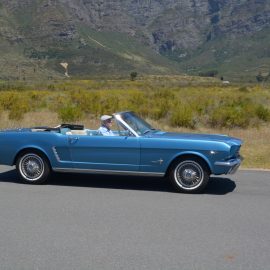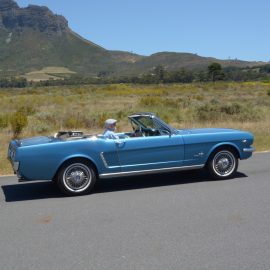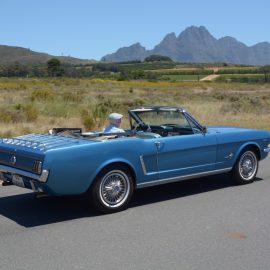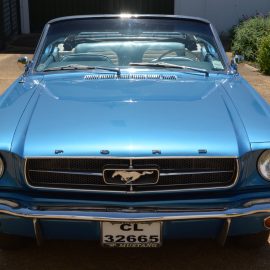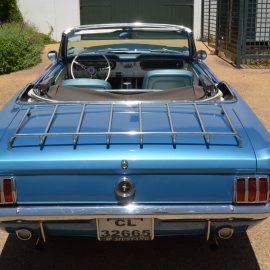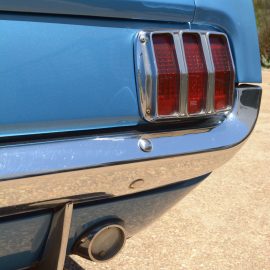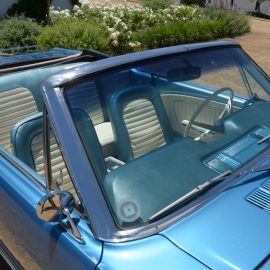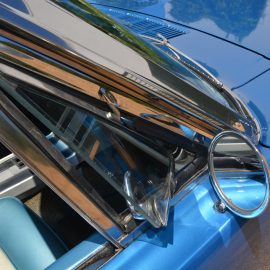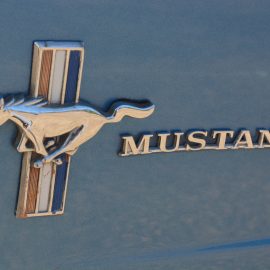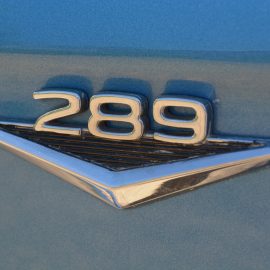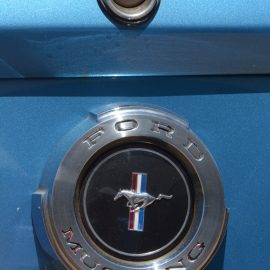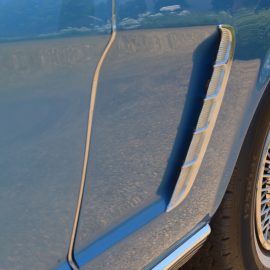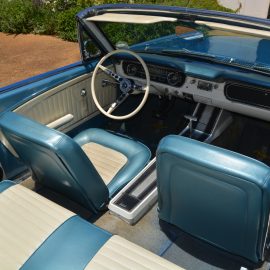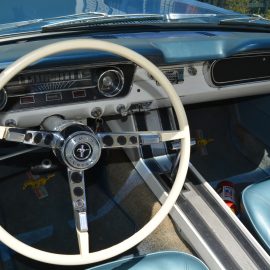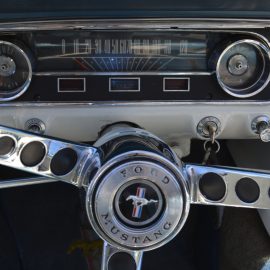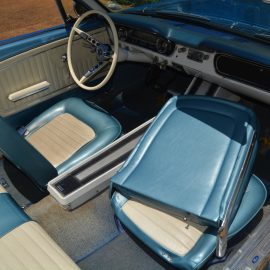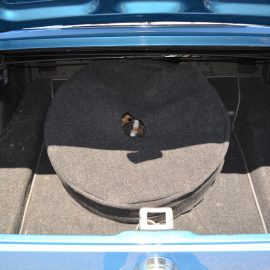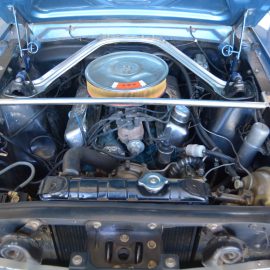
29 Nov Collection In Action: Ford Mustang 1965
Ride that pony! Mike Monk gets nostalgic about one the world’s most iconic sports cars…
The first-generation Ford Mustang was manufactured from March 1964 until 1973. Surprisingly, in a company history book ‘The Ford Century’, it states that the car was named after the WWII fighter aircraft rather than the horse that became the model’s emblem. It was based on the chassis, suspension, and drivetrain components derived from the Ford Falcon and Fairlane and was introduced to the public at the New York World Fair on 17 April 1964, initially as a hardtop and convertible. The fastback version was added to the line-up in August 1964. At the time, no-one could have expected the Mustang to not only create a new class of automobile – the ‘pony car’ – and that six decades later the name is still going strong. The Mustang’s long bonnet, short boot proportions suggested powerful engines and driving fun, and was even described as having “square-jawed looks and carefree carelessness”. The clean lines and rakish proportions made it the only car to have won a Tiffany Award For Excellence in American Design.
The charismatic auto executive Lee Iacocca – then Ford’s Vice-president and General Manager – and his assistant general manager and chief engineer, Donald N Frey, supervised the development of the Mustang in a record 18 months, commencing September 1962. Drawing on inspiration from a mid-engined Ford Mustang concept vehicle, Iacocca ordered development of a new “small sporting car” and Ford’s three design studios (Ford, Lincoln-Mercury, and Advanced Design) were challenged to create proposals for the new vehicle.
The design teams were given five goals:
It must hold four people, have bucket seats and a floor-mounted gearshift.
It must weigh no more than 2 500 pounds (1 100 kg)
It must be no more than 180 inches (4,6 metres) in length.
It must sell for less than $2 500.
It must have multiple power, comfort, and luxury options.
The Ford studio ultimately produced the winning design under Project Design Chief Joe Oros and his team of L David Ash, Gale Halderman, John Foster and George Schumaker. “Anyone that says they designed the car by themselves is wrong”, said Ash. “Iacocca didn’t design it. He conceived it. He’s called the father of it, and, in that respect, he was. In his book, Iacocca flat out comes and says I did the car. It’s right there in print, but I did not design it in total, nor did Oros. It was designed by a group.” Developed in secret, when Iacocca saw the bright red glass fibre mock-up for the first time, he said, “We’ve got to do it!”
When introduced, the base hardtop model boasted a 170ci (2,8 litre) straight-six engine as used in the Falcon, as well as a three-speed manual transmission. It sold for $2 368. Ford’s marketing team went into high gear promoting the Mustang, even to providing Newsweek and some other magazines a preview picture of the car the month before launch. More than 100 Mustangs were loaned to reporters for test drives prior to the car being made available for public introduction. Iacocca made the cover of Newsweek and Time magazines in the same week.
Dealers were swamped with public demand, receiving more than 22 000 orders on the first day. In the first year, sales were 418 812 units, and more than one million Mustangs were sold before its second birthday. It was one of the fastest-selling cars of all time.
Since it was introduced four months before the 1965 production year, the earliest Mustangs are widely referred to as the ‘1964½’ model by enthusiasts, but all were marketed by Ford as 1965 models. Standard equipment for the early 1965 Mustangs included black front seat belts, a glove box light, and a padded Falcon-derived dashboard.
Several changes occurred in August at the start of the ‘normal’ 1965 model year. These cars are known as ‘late 65s’. At this time the engine line-up comprised a 200ci (3,3 litre) six-cylinder, a new 200 hp (150 kW) 289ci (4,7 litre) engine with a two-barrel carburettor as the base V8, a 225 hp (168 kW) four-barrel carb version, followed by an unchanged 289ci 271 hp (202 kW) HiPo equipped with a 4-barrel Autolite carburettor. The DC generator was replaced by a new AC alternator on all Fords.
In December 1964, Ford SA announced that all three Mustang models were available as a luxury importation, costing around R3 500, which included a R1 000 import tax! Demo models did a tour of the Republic and on the day they were in Cape Town, 20 orders were placed!
I have seen the Mustang described as “A poor man’s (Ford) Thunderbird for the working girl” and “A virility symbol to American youth in the 1960s”, neither of which has anything to do with me. When it was launched, I had just finished school and had started an apprenticeship, but I was one of the many who was wowed at the Mustang, and after watching Steve McQueen’s exploits in a GT in the iconic 1968 movie Bullitt, I became a fan for life. I have driven a few examples over the years, but with the sun shining above the Franschhoek mountains and FMM’s ’65 blue convertible standing in front of me, who was I to resist?
It is fitted with the base, small-block 289 that apart from the 150 kW at 4 400 r/min, offers 382 N.m of torque at 2 400. It has the three-speed autobox that helped provide a top speed of 193 km/h (120 mph) and a 0-100 km/h time of 8,9 seconds. But at this time in its career, the Mustang was plain and simply a sporting car rather than an out and out sports car – Carroll Shelby soon put that to rights!
Once the rumbly V8 was up and running, the Mustang was sheer bliss. The two-tone bucket seat helps provide a comfortable driving position. Performance is ample and effortless – prod the accelerator and it responds with a requisite roar – but rather relax and revel in the al fresco experience, enjoying the sights and sounds around you. The dished, colour-coded three-spoke steering wheel does its job without much effort, but it is important to keep in mind that American cars of the time – even sporty ones – were hardly nimble through the twisties. It’s more for California Cruisin’… The ride is firm, just as expected, but not an issue. All this, AND capable of carrying four passengers, to anyone with petrol, in their veins, this is a dream machine.
Wilson Pickett sang to Sally, “Guess you better slow your Mustang down”. Not really. Rather stick to what he sings in the chorus – “All you want to do is ride around Sally,
ride, Sally, ride…




